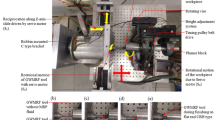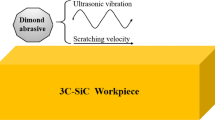Abstract
To explore the formation mechanism of residual stress in the high-speed grinding of noncircular equidistant profiles, orthogonal experiments of three grinding parameters—the grinding wheel speed, workpiece speed, and grinding depth—were designed. A ceramic bond CBN grinding wheel was used for the high-speed grinding of noncircular equidistant profile by the X-C axis linkage. The effects of the grinding parameters on the grinding temperature, surface roughness, and residual stress were analyzed. The results show that with the increase of grinding wheel speed, the grinding temperature and residual stress increase, and the surface roughness decreases. With the increase of workpiece speed, the grinding temperature and residual stress decrease, and the surface roughness increases. With the increase of grinding depth, the grinding temperature, residual stress, and surface roughness increase. Besides, the grinding depth has the greatest influence on the residual stress, followed by the grinding wheel speed and workpiece speed.









Similar content being viewed by others
Data availability
The authors confirm that the data and materials supporting the findings of this study are available within the article.
References
Mahdi M, Zhang LC (1999) Applied mechanics in grinding. part 7: residual stress induced by the all coupling of mechanical deformation, thermal deformation and phase transformation. Int J Mach Tool Manuf 39:1285–1298. https://doi.org/10.1016/S0890-6955(98)00094-7
Ding WF, Zhang LC, Li Z, Zhu YJ, Su HH, Xu JH (2017) Review on grinding-induced residual stresses in metallic materials. Int J Adv Manuf Technol 88:2939–2968. https://doi.org/10.1007/s00170-016-8998-1
Zhang XM, Xiu SC, Shi XL, Liu MH (2014) Influence of small depth cut on grinding surface micro-structure damage and mechanism. J Northeast Univ (Nat Sci) 35(7):1010–1014. https://doi.org/10.12068/j.issn.1005-3026.2014.07.022
Deng ZH, Jin Q, An L (2008) Finite-element simulation and experiment on the residual stress when grinding nanostructured WC/12Co coatings. J Mech Eng 44(7):58–62. https://doi.org/10.3321/j.issn:0577-6686.2008.07.009
Zoei MS, Sadeghi MH, Salehi M (2016) Effect of grinding parameters on the wear resistance and residual stress of HVOF-deposited WC–10Co–4Cr coating. Surf Coat Technol 307:886–891. https://doi.org/10.1016/j.surfcoat.2016.09.067
Wang CY, Zhao J, Zhu HW, Zheng QQ, Sun QZ (2018) Effect of grinding parameters on grinding residual stress of EA4T steel. Sci Technol Innov 32:22–23. https://doi.org/10.3969/j.issn.1673-1328.2018.32.010
Wang D, Wang JJ, Li L (2020) Study on surface integrity of cylindrical grinding 18CrNiMo7-6. J Chongqing Inst Technol 34(4):76–86. https://doi.org/10.3969/j.issn.1674-8425(z).2020.04.010
Zhang YX, Yang X, Yuan SS, Zhu JH, Wang D (2021) Residual stress of high-speed cylindrical grinding of 18CrNiMo7-6 steel. China Mech Eng 32(5):540–546. https://doi.org/10.3969/j.issn.1004-132X.2021.05.005
Azarhoushang B, Daneshi A, Lee DH (2017) Evaluation of thermal damages and residual stresses in dry grinding by structured wheels. J Cleaner Prod 142:1922–1930. https://doi.org/10.1016/j.jclepro.2016.11.091
Florian B, Heiner M, Carsten H, Daniel M, Jérémy E (2020) Development of surface residual stress and surface state of 42CrMo4 in multistage grinding. Procedia CIRP 87(C):198–203. https://doi.org/10.1016/j.procir.2020.02.095
Li F, Li XK, Wang T, Rong YM, Steven LY (2020) In-process residual stresses regulation during grinding through induction heating with magnetic flux concentrator. Int J Mech Sci 172:105393. https://doi.org/10.1016/j.ijmecsci.2019.105393
Wang ZM, Wang HN, Li X, Yu JH, Xu RF (2020) Surface integrity of powder metallurgy superalloy FGH96 affected by grinding with electroplated CBN wheel. Procedia CIRP 87(C):204–209. https://doi.org/10.1016/j.procir.2020.02.101
Dražumerič R, Roininen R, Badger J, Krajnik P (2018) Temperature-based method for determination of feed increments in crankshaft grinding. J Mater Process Technol 259:228–234. https://doi.org/10.1016/j.jmatprotec.2018.04.032
da Silva LR, da Silva DA, dos Santos FV, Duarte FJ (2019) Study of 3D parameters and residual stress in grinding of AISI 4340 steel hardened using different cutting fluids. Int J Adv Manuf Technol 100:895–905. https://doi.org/10.1007/s00170-018-2763-6
Choudhary A, Naskar A, Paul S (2018) Effect of minimum quantity lubrication on surface integrity in high-speed grinding of sintered alumina using single layer diamond grinding wheel. Ceram Int 44:17013–17021. https://doi.org/10.1016/j.ceramint.2018.06.144
Zhao ZC, Qian N, Ding WF, Wang Y, Fu YC (2020) Profile grinding of DZ125 nickel-based super alloy: grinding heat, temperature field, and surface quality. J Manuf Prosess 57:10–22. https://doi.org/10.1016/j.jmapro.2020.06.022
Sosa AD, Echeverría MD, Moncada OJ, Sikora JA (2007) Residual stresses, distortion and surface roughness produced by grinding thin wall ductile iron plates. Int J Mach Tools Manuf 47(2):229–235. https://doi.org/10.1016/j.ijmachtools.2006.04.004
Deng XS, Zhang FL, Liao YL, Bai FH, Li KJ, Zhou YM, Wu SH, Wang CY (2022) Effect of grinding parameters on surface integrity and flexural strength of 3Y-TZP ceramic. J Eur Ceram Soc 42(4):1635–1644. https://doi.org/10.1016/j.jeurceramsoc.2021.12.018
Fan ZH, Tian YB, Zhou Q, Shi C (2020) A magnetic shear thickening media in magnetic field-assisted surface finishing. Proc IMechE Part B: J Eng Manuf 234(6–7):1069–1072. https://doi.org/10.1177/0954405419896119
Wang PZ, He ZS, Zhang YX, Zhao SS (2017) Control of grinding surface residual stress of Inconel 718. Procedia Eng 174:504–511. https://doi.org/10.1016/j.proeng.2017.01.174
Tian YB, Li LG, Liu B, Han JG, Fan ZH (2020) Experimental investigation on high-shear and low-pressure grinding process for Inconel718 superalloy. Int J Adv Manuf Technol 107(7–8):3425–3435. https://doi.org/10.1007/s00170-020-05284-z
Funding
This study is financially supported by the Scientific Research Fund of Hunan Provincial Education Department (Grant No. 20A202), Natural Science Foundation of Hunan Province (Grant Nos. 2020JJ5178 and 2020JJ4024), and Open Foundation of Hunan Provincial Key Laboratory of High Efficiency and Precision Machining of Difficult-to-Cut Material (Grant No. E21849).
Author information
Authors and Affiliations
Contributions
Wei Liu developed the idea for the study, Xinyu Shi, Houcai Yuan, Tao Liu, and Shishuai Du did the analyses. Houcai Yuan and Wei Liu wrote the paper.
Corresponding author
Ethics declarations
Ethical approval
This article has not been published or submitted elsewhere.
Competing interests
The authors declare no competing interests.
Additional information
Publisher's note
Springer Nature remains neutral with regard to jurisdictional claims in published maps and institutional affiliations.
Rights and permissions
Springer Nature or its licensor (e.g. a society or other partner) holds exclusive rights to this article under a publishing agreement with the author(s) or other rightsholder(s); author self-archiving of the accepted manuscript version of this article is solely governed by the terms of such publishing agreement and applicable law.
About this article
Cite this article
Liu, W., Yuan, H., Shi, X. et al. Experimental study on residual stress in high-speed grinding of noncircular equidistant profile. Int J Adv Manuf Technol 123, 3399–3406 (2022). https://doi.org/10.1007/s00170-022-10454-2
Received:
Accepted:
Published:
Issue Date:
DOI: https://doi.org/10.1007/s00170-022-10454-2




